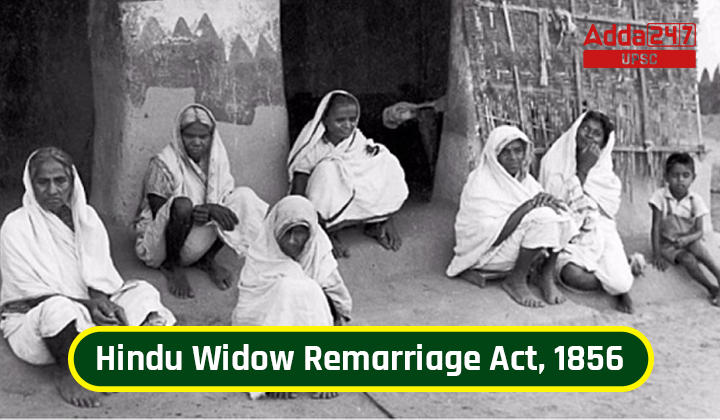Table of Contents
Hindu Widow Remarriage Act
The introduction of the Widow Remarriage Act was a major change for women during that time. Ishwar Chandra Vidyasagar played a major role in making this happen. Before this Act, the practice of the Sati custom was also abolished by Lord William Bentick. On July 16, 1856, the Hindu Widow Remarriage Act was passed, allowing Hindu widows to remarry. It became a law on July 26, 1856. This act also aimed to protect and improve the status of men who married widows. It was an important step in empowering women.
Hindu Widow Remarriage Act 1856 Overview
Here’s a quick overview of the act provided in the table below:
| Hindu Widow Remarriage Act, 1856 Overview | |
| Hindu Widow Remarriage Act Long Title | Hindu Remarriage Act, 1856 or Act XV, 1856 |
| Territorial Extent | Territories under East India Company rule |
| Passed by | Lord Canning (Drafted by Lord Dalhousie) |
| Enacted | 26th July 1856 |
| Commenced | 26th July 1856 |
What is Hindu Widow Remarriage Act 1856?
- The Hindu Widow Remarriage Act of 1856 was introduced in British India during the colonial period.
- It was advocated by social reformers like Ishwar Chandra Vidyasagar and supported by progressive thinkers.
- The Act aimed to uplift widowed women in Hindu society.
- Before this act, widows in Hindu communities faced social ostracism and were not allowed to remarry.
- The Act legalized the remarriage of Hindu widows, granting them the right to begin a new life with a new spouse.
- This legislation was a bold move to promote gender equality and challenge deep-rooted societal norms.
- It encountered resistance and opposition from conservative groups.
- The Hindu Widow Remarriage Act marked a significant milestone in the fight for women’s rights and social reform in India.
- It served as a precedent for future legal reforms in the country.
Who introduced Widow Remarriage?
The Widow Remarriage Act of 1856 in British India was introduced by Lord Dalhousie, the Governor-General of India at the time. However, it was championed and advocated by social reformers like Ishwar Chandra Vidyasagar, who played a crucial role in promoting and supporting the idea of widow remarriage.
History of Hindu Widow Remarriage Act 1856
- The Hindu Widow Remarriage Act of 1856 was an important law in India’s history. Before this law, widowed women in Hindu families were treated very badly. They were not allowed to remarry, and they had to live a tough and lonely life. Some people thought that if a widow remarried, it was wrong and against their religion.
- But some good people, like Ishwar Chandra Vidyasagar and Raja Ram Mohan Roy, realized that this was unfair and wanted to change it. They thought widowed women should have the right to marry again if they wanted. So, the British government, who ruled India at that time, made a law called the Hindu Widow Remarriage Act in 1856. This law said that widowed Hindu women could remarry.
- Many people didn’t like this law, especially those who believed in old customs. They said it went against their religion. But this law was a big step towards fairness and equality for women. It allowed widowed women to have a better life, find love again, and be accepted by society. It also paved the way for more changes in the future to make life better for women in India. So, the Hindu Widow Remarriage Act of 1856 was an important part of India’s history and a good thing for women.
Condition of Widows Before the Introduction of the Act
- In some parts of India, particularly among upper-caste Hindu widows, strict customs dictated a life of hardship and austerity.
- Widow remarriage was forbidden, regardless of the widow’s age or whether her previous marriage had been consummated.
- Widows were required to wear a plain white saree made of coarse fabric.
- Many widows were forced to shave their heads and were not allowed to wear a blouse.
- They faced social ostracism, being excluded from festivals and often abandoned by both family and society.
- Ishwar Chandra Vidyasagar cited Hindu scriptures to argue that widow remarriage was consistent with Hinduism.
- His efforts led to the enactment of the Hindu Widow Remarriage Act by Lord Canning, which applied to the entirety of British India, allowing widows the right to remarry.
Major Changes after Hindu Widow Remarriage Act 1856 Establishment
- The law stated that marriages among Hindus wouldn’t be considered invalid if the woman had been married or promised to someone who had already died, despite any traditional customs or interpretations of Hindu Law.
- It also ensured that widows who remarried would have the same rights and inheritances as women marrying for the first time.
- However, any inheritance from their deceased husband would be forfeited.
- The law also protected the rights of men marrying widows.
- Among lower-caste communities, widow remarriage was already common.
- This law was a significant step in reforming Indian society during the 19th century.
- The first widow remarriage under this law happened on December 7, 1856, in north Calcutta, and the groom was a close friend’s son of Ishwar Chandra Vidyasagar.
| Relatable Article | |
| Muslim Women Act 2019 | Dowry Prohibition Act 1961 |
| Child Marriage Restraint Act 1929 | |



 TSPSC Group 1 Question Paper 2024, Downl...
TSPSC Group 1 Question Paper 2024, Downl...
 TSPSC Group 1 Answer key 2024 Out, Downl...
TSPSC Group 1 Answer key 2024 Out, Downl...
 UPSC Prelims 2024 Question Paper, Downlo...
UPSC Prelims 2024 Question Paper, Downlo...
